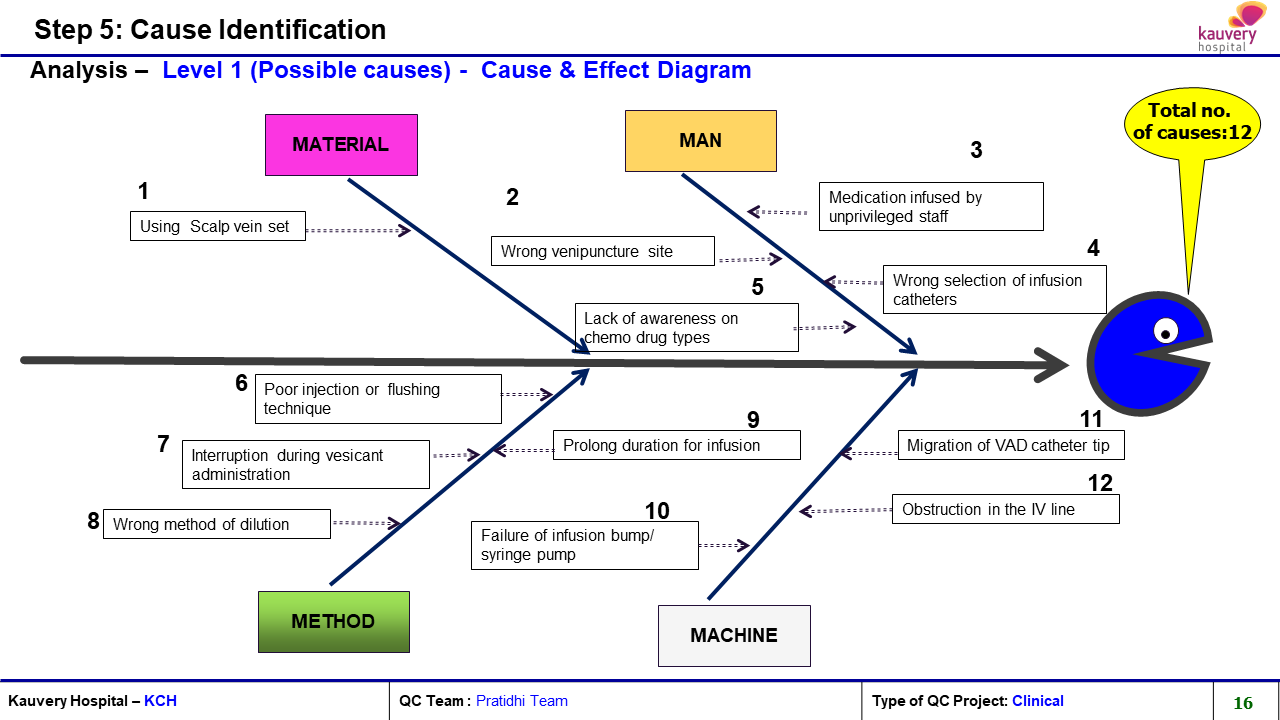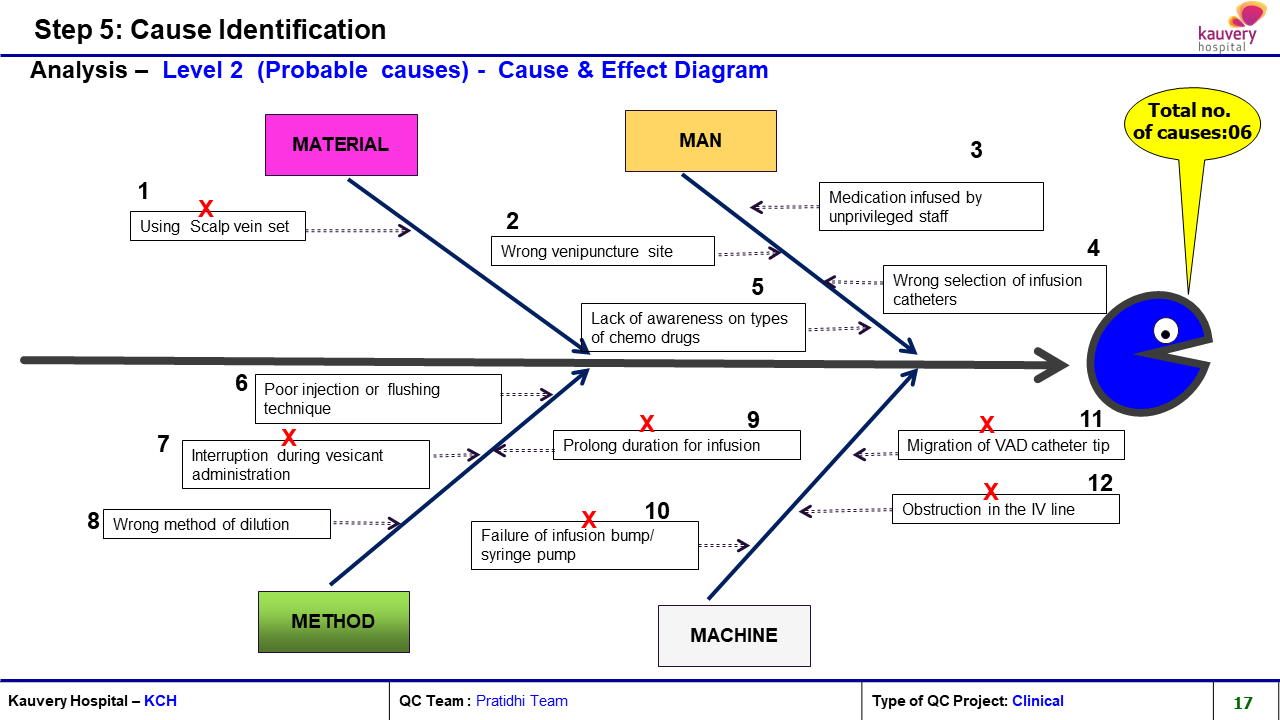Prevention of extravasation in Oncology unit
Anandhi Sathiyakumar1*, Deepa2, Bhagavathy3, Stella Towncent 4
1Nursing Director, Kauvery Hospital, Alwarpet, Tamilnadu, India
2 Nursing Superintendent, Kauvery Hospital, Tamilnadu, India
3Oncology Incharge, Alwarpet, Tamilnadu, India
4Clinical Nurse Educator, Kauvery Hospital, Alwarpet, Tamilnadu, India
*Correspondence: nursingdirector.kch@kauveryhospital.com
Study Title: A study to assess the effectiveness of visual management tool to standardize the administration of chemotherapy to reduce the extravasation in oncology unit.
Objective
To assess the effectiveness of visual management tool for chemotherapy administration among staff nurse in study group.
Aim
To reduce the number of extravasation for the patients undergoing chemotherapy and therefore enhancing the patient safety.
Background
Intravenous (IV) chemotherapeutic medications have the potential to cause extravasation injury or tissue necrosis at the site of administration. Extravasation results in local reactions ranging from local irritation to severe tissue necrosis of the skin, surrounding vasculature, and supporting structures. This is one of the quality indicator where it affects the hospital reputation, hence it has to be prevented.
Methodology
- Research approach: Quantitative approach was adopted.
- Research design: The research design used for this study was quasi experimental nonequivalent one group posttest only design.
- Setting of the study: Oncology department, Chennai.
- Sample: The nurses who have satisfied the sample selection criteria were the samples of the study.
- Sample size: It consists of 30 staff nurses who were working in the oncology unit.
- Sampling technique: The samples were selected by purposive sampling technique.
Root Cause Analysis
Identified the Possible causes of extravasation done through Gemba and data analysis. The findings are plotted using ishikawa diagram.


Measurement and Tools
Application of PDSA (Plan Do Study Act) for the prevention of extravasation for chemotherapy patients and fixed the deadlines from Aug 2022 to Aug 2023.
Date Analysis and Interpretation
| Need assessment scale which was used to identify challenges of the staff nurse working in oncology unit |
Group |
Intervention (X) |
Post Assessment (O) |
| Oncology Unit-Staff Nurses | A visual management tool for nurses to standardize the administration of chemotherapy drugs.
Identified qualified nurses and privileged them. CNE program organized for the continual knowledge improvement on extravasation prevention. |
Clinical pathway created
Extravasation protocol updated and nurse adherence to the evidence based practice is evaluated frequently. Frequent audit done to rule out the effectiveness of chemotherapy administration. |
Extravasation rate |
Pre-intervention period |
Intervention period |
Post-intervention period |
| No standard SOP for chemotherapy
No cannula characteristics No privileged staff No training – improving knowledge and strengthening the competency |
A visual management tool for nurses to standardize the administration of chemotherapy drugs
Identified qualified nurses and privileged them CNE program organized for the continual knowledge improvement on extravasation prevention |
Clinical pathway created
Extravasation protocol updated and nurse adherence to the evidence based practice is evaluated frequently Frequent audit done to rule out the effectiveness of chemotherapy administration |
|
| Findings – Grade 1 | 18 no’s | 6 no’s | 1 |
| Grade 2 | 12 no’s | 4 no’s | 1 |
| Grade 3 | 5 no’s | 2 no’s | 0 |
| Grade 4 | 1 | 0 | 0 |
| Grade 5 | 0 | 0 | 0 |
Result
Time period |
Number |
Mean |
SD |
Mean Diff |
P Value |
| Pre-intervention period | 36 | 7.2 | 6.8 | -6.8 | P < 0.0001 |
| Post-intervention period | 5 | 0.4 | 0.5 |
The P-value is the probability of obtaining the observed difference between the samples is the null hypothesis were true. Hence the study is significant.
Findings of the study
Analysis |
Responsible person |
Action taken |
Result |
| Wrong venipuncture site [2], Poor injection or flushing technique[6] , Wrong method of dilution[8] & Lack of awareness on types of chemo drugs [5] | Unit Incharge and Nurse Educators | Structure training program
Knowledge regarding IV cannulation and techniques for chemotherapy Knowledge regarding vesicant drugs Hands on training for selection of veins, flushing technique and dilution |
Staff were expert in handling chemotherapy patients |
| Medication infused by unprivileged staff [3] | Unit Incharge | Identified staff and sent them for the Onco training certification program | Staff were privileged to handle the |
| Wrong selection of infusion catheters [4] | Doctors | Nurse empowered to inform about the lines and duration | Doctors were able to insert the lines based on the duration. |
Conclusion
The present study assessed the effectiveness of visual tool management among the nurses in oncology unit. The findings revealed that the visual management tool was effective in enhancing the knowledge and practice among nurses during chemotherapy administration. Thus it can be incorporated in the education and training of nurses working in general health care setting.
Reference
1. Coyle CE, Griffie J, Czaplewski LM. Eliminating extravasation events: a multidisciplinary approach. J Infus Nurs. 2014;37(3):157-64.
2. Hadaway L. Infiltration and extravasation. Am J Nurs. 2007;107(8):64-72.
3. Cassagnol M, McBride A. Management of Chemotherapy Extravasations. US Pharm, 2009;34(9):3-11.
4. Polovich M, Olsen M, Le Febvre K (eds.). Chemotherapy and biotherapy guidelines and recommendations for practice. 4th ed. Pittsburgh, Pennsylvania: Oncology Nursing Society; 2014;18(3):283-7.
5. Barbee MS, Owonikoko TK, Harvey RD. Taxanes: vesicants, irritants, or just irritating? Ther Adv Med Oncol. 2014;6(1):16-20.
6 Polovich M, White J, Kelleher L. Chemotherapy and Biotherapy Guidelines and Recommendations for Practice. 2nd ed. Pittsburgh, PA: Oncology Nursing Society; 2005.
7. Ener RA, Meglathery SB, Styler M. Extravasation of systemic hemato-oncological therapies. Ann Oncol. 2004;15(6):858-62.
8. Sauerland C, Egelking C, Wickman R, Corbi D. Vesicant extravasation part I: mechanisms, pathogenesis, and nursing care to reduce risk. Oncol Nurs Forum. 2006;33(6):1134-41.

Ms. Anandhi Sathiyakumar
Nursing Director.

Ms. Deepa,
Nursing Superintendent.

Ms. Devika,
OR Assistant Nursing Superintendent.

Ms. Stella Towncent,
Clinical Nurse Educator.
